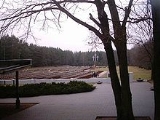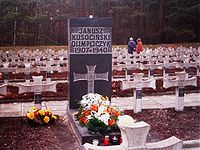
Palmiry
Encyclopedia


Village
A village is a clustered human settlement or community, larger than a hamlet with the population ranging from a few hundred to a few thousand , Though often located in rural areas, the term urban village is also applied to certain urban neighbourhoods, such as the West Village in Manhattan, New...
in the administrative district of Gmina Czosnów
Gmina Czosnów
Gmina Czosnów is a rural gmina in Nowy Dwór Mazowiecki County, Masovian Voivodeship, in east-central Poland. Its seat is the village of Czosnów, which lies approximately south-east of Nowy Dwór Mazowiecki and north-west of Warsaw....
, within Nowy Dwór Mazowiecki County
Nowy Dwór Mazowiecki County
Nowy Dwór Mazowiecki County is a unit of territorial administration and local government in Masovian Voivodeship, east-central Poland. It came into being on January 1, 1999, as a result of the Polish local government reforms passed in 1998. Its administrative seat and largest town is Nowy Dwór...
, Masovian Voivodeship
Masovian Voivodeship
-Administrative division:Masovian Voivodeship is divided into 42 counties : 5 city counties and 37 "land counties"...
, in east-central Poland. It is located at the edge of the Kampinos Forest
Kampinos Forest
Kampinos Forest is a large forest complex located to the west of Warsaw in Poland. It covers a large part of the ancient valley of Vistula, between Vistula and Bzura rivers. Once a gigantic forest covering 670 km² of central Poland, it currently covers roughly 240 km².Most of the...
, approximately 4 kilometres (2 mi) south-east of Czosnów
Czosnów
Czosnów is a village in Nowy Dwór Mazowiecki County, Masovian Voivodeship, in east-central Poland. It is the seat of the gmina called Gmina Czosnów. It lies approximately southeast of Nowy Dwór Mazowiecki and northwest of Warsaw....
, 11 km (7 mi) south-east of Nowy Dwór Mazowiecki
Nowy Dwór Mazowiecki
Nowy Dwór Mazowiecki is a town in central Poland with ca. 42500 inhabitants . It is situated in the Masovian Voivodeship ; previously, it was in Warszawa Voivodeship...
, and 23 km (14 mi) north-west of Warsaw
Warsaw
Warsaw is the capital and largest city of Poland. It is located on the Vistula River, roughly from the Baltic Sea and from the Carpathian Mountains. Its population in 2010 was estimated at 1,716,855 residents with a greater metropolitan area of 2,631,902 residents, making Warsaw the 10th most...
. In 2000 the village had an approximate population of 220.
During World War II
World War II
World War II, or the Second World War , was a global conflict lasting from 1939 to 1945, involving most of the world's nations—including all of the great powers—eventually forming two opposing military alliances: the Allies and the Axis...
, between 1939 and 1943, the village and the surrounding forest was one of the sites of German mass executions of Jews, Polish intelligentsia
Intelligentsia
The intelligentsia is a social class of people engaged in complex, mental and creative labor directed to the development and dissemination of culture, encompassing intellectuals and social groups close to them...
, politicians and athletes, killed during the AB Action. Most of the victims were first arrested and tortured in the Pawiak
Pawiak
Pawiak was a prison built in 1835 in Warsaw, Poland.During the January 1863 Uprising, it served as a transfer camp for Poles sentenced by Imperial Russia to deportation to Siberia....
prison in Warsaw
Warsaw
Warsaw is the capital and largest city of Poland. It is located on the Vistula River, roughly from the Baltic Sea and from the Carpathian Mountains. Its population in 2010 was estimated at 1,716,855 residents with a greater metropolitan area of 2,631,902 residents, making Warsaw the 10th most...
, then transferred to the execution site. In total, the remains of at least 2,115 men and women were exhumed, but it is probable that not all bodies were found. Listed among the known victims are:
- Juliusz Dąbrowski, journalist and one of the leaders of Polish ScoutingZwiazek Harcerstwa PolskiegoZwiązek Harcerstwa Polskiego is the coeducational Polish Scouting organization recognized by the World Organization of the Scout Movement and the World Association of Girl Guides and Girl Scouts. It was founded in 1918 and currently is the largest Scouting organization in Poland...
- Ludwik Dyzenhaus, lawyer
- Witold HulewiczWitold HulewiczWitold Hulewicz was a Polish poet, literary critic, translator and publisher. He fought in the German army during World War I, then on the Polish side during the Greater Poland Uprising . He lived in Poznań, later, in Wilno and Warsaw. He founded a literary magazine, Zdrój, and worked with the...
, poet and radio journalist - Stefan KopećStefan KopecStefan Kopeć was a Polish biologist and pioneer of insect endocrinology, who studied at the Jagiellonian University in Kraków. He received his PhD. there in 1912, and worked at Puławy Agricultural Research Station in Poland between 1915 and 1920...
, biologist and physiologist, professor of the University of WarsawUniversity of WarsawThe University of Warsaw is the largest university in Poland and one of the most prestigious, ranked as best Polish university in 2010 and 2011... - Janusz KusocińskiJanusz KusocinskiJanusz Tadeusz Kusociński was a Polish athlete, winner in the 10000 m event at the 1932 Summer Olympics....
, athlete, winner of 10 000 m at the 1932 Summer Olympics. - Mieczysław Niedziałkowski, politician of the Polish Socialist PartyPolish Socialist PartyThe Polish Socialist Party was one of the most important Polish left-wing political parties from its inception in 1892 until 1948...
- Stanisław Piasecki, journalist, politician and art critic
- Jan Pohoski, politician, former deputy president of WarsawPresident of WarsawThe Mayor of Warsaw, or more properly the President of Warsaw is the head of the capital of Poland....
- Dawid PrzepiórkaDawid PrzepiórkaDawid Przepiórka was a prominent Polish chess player of the early twentieth century.Dawid Przepiórka was born 22 December 1880 in Warsaw, Poland , to a family of wealthy landowners and entrepreneurs of Jewish extraction...
, chess master - Maciej RatajMaciej RatajMaciej Rataj was a Polish politician, socialist activist and writer.Born in the village of Chłopy near Lwów on 19 February 1884, he attended a gymnasium in Lwów and studied classical linguistics at the University of Lwów...
, politician, Marshal of the Sejm - Franz Sturm, dental surgeon
- Pinkus Topaz, photagrapher
- Kazimierz ZakrzewskiKazimierz ZakrzewskiKazimierz Zakrzewski was a Polish historian and publicist, a professor of the University of Warsaw....
, scientist, professor of the University of WarsawUniversity of WarsawThe University of Warsaw is the largest university in Poland and one of the most prestigious, ranked as best Polish university in 2010 and 2011...
In 1946, the bodies were exhumed and reburied in a new cemetery, situated approximately 5 kilometres from the village itself. The reburial site has been a Polish national mausoleum since 1948.

